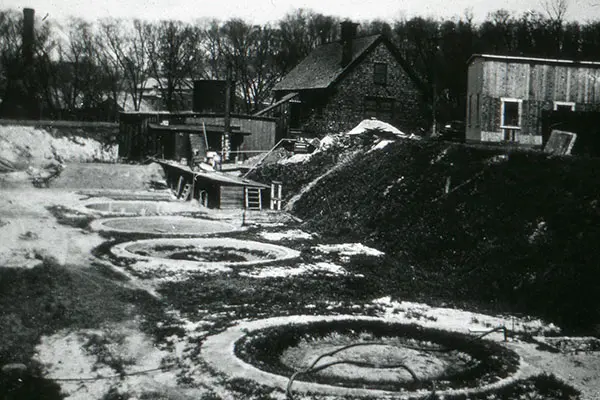Prof. Chad Montrie Challenges “The Myth of Silent Spring” in New Book
 Image by Conservation Law Foundation
Image by Conservation Law Foundation
02/23/2018
By Katharine Webster
The story goes like this: Rachel Carson’s eloquent 1962 book “Silent Spring,” about the effects of synthetic pesticides like DDT on songbirds, bees, wildlife and humans, launched the American environmental movement among the educated, white suburbanites who read it.
But that story ignores a long and complicated history, says Prof. Chad Montrie of the History Department.
In his new book, “The Myth of Silent Spring: Rethinking the Origins of American Environmentalism,” Montrie shows how the environmental movement started well before 1962 and that it was largely fueled by working-class, minority and immigrant efforts to combat the devastating effects of industrial pollution and other environmental hazards on people in cities and the countryside.
Montrie, who studied labor and environmental history at the University of Louisville and earned his master’s and doctorate at Ohio State University, is the author of four books, including “A People’s History of Environmentalism in the United States.”
Among the courses he teaches are Alcohol in American History, Food in American History, American Environmental History, Radicalism in American History, The U.S. in the 1960s, The War in Vietnam and Malcolm X.
He spoke with us recently about “The Myth of Silent Spring,” which won the grand prize at the 2018 Green Book Festival.
Q: How did you become an environmental historian?
A: When I was in college, I took two classes, one in labor history and one in environmental history, both with the same professor, and that got me started thinking about ways to combine the two.
After I finished my master’s degree, I spent the summer of 1997 working as a labor organizer for the United Food and Commercial Workers union in eastern Kentucky. I found my dissertation topic there: mountain people’s opposition to strip-mining by coal companies in the 1960s and the 1970s.
It was exactly the right project to think about a real case where labor and environment overlapped. Strip-mining is a highly mechanized form of coal extraction requiring far fewer miners, which means it puts miners out of work. At the same time, strip-mining ravages the land and waterways. The story I tell about the militant opposition to this eventually became my first book, “To Save the Land and People.”
Q: You revisit the Appalachian movement against strip-mining in “The Myth of Silent Spring.” Why?
A: In the early 1970s, the people of southern Appalachia came very close to getting a federal law passed to ban strip-mining. When I first started researching this in 1997, I was baffled that everyone outside the mountains seemed to have forgotten about it, because it was hugely important and nationally recognized at the time.
Also, as I’ve listened to environmental activists talk about fossil fuels and climate change, it’s amazing to me that they ignore coal extraction and the long-established movement to rein it in. I suspect this is because they’ve embraced a stereotypical view of Appalachia as a resource colony populated by “hillbillies” who are too fatalistic to fight back.
So in my book, I look at what it means that the Appalachian struggle against strip-mining is left out of the story we tell about the history of the environmental movement – and how that incomplete history adversely impacts our ability to build a movement that fully recognizes the social dimensions of environmental questions.
Q: You have other examples that have been more widely documented and studied, like the migrant farmworkers in California who suffered from exposure to the pesticides Carson wrote about.
A: I’m not questioning Rachel Carson’s science in “Silent Spring,” but she didn’t pay much attention to the plight of Mexican and Mexican-American farmworkers. In fact, her call for change led growers to switch to pesticides that were less persistent and less toxic for consumers, but that were more toxic in the short term and worse for the farmworkers’ health. By the mid-1960s, 71 percent of migrant farmworkers had symptoms of chemical poisoning.

Q: Tell me about some other cases you’ve researched or written about, especially in the Lowell and Lawrence areas.
A: In the early 19th century, textile mills in Lowell and Lawrence built canals and dams to control water flow. River meadows where people cut grass to feed their cattle were flooded, and fish that came upstream to spawn – an important food source for many people – were blocked or poisoned.
The mills also dumped millions of gallons of noxious chemicals into the water every day, where they mixed with raw sewage from growing cities. A lack of sanitation and clean drinking water led to epidemics of cholera and other infectious diseases, along with generally noxious living conditions for the workers and their families.
Individual and organized attempts to rein in water pollution recognized the role that social inequality played in who suffered, as well as the role of the corporations. The connection between social justice and sanitation here was effectively the beginning of environmental consciousness in the United States.
 Image by Conservation Law Foundation
Image by Conservation Law Foundation
A: People in corporations and government have tried to drive a wedge between workers and environmentalists by saying, “You have to choose between jobs and the environment.” In fact, there was a lot of labor-led environmentalism in the 20th century by unions that saw the fight against dangerous industrial pollutants as part of the larger struggle for social and economic justice.
Although there are some noteworthy “blue-green coalition” efforts today, labor-environmental alliances are weaker. I think if mainstream environmental organizations paid more attention to labor’s history of involvement with environmental issues, they might realize that it’s possible to build those partnerships again.
Q: You’ve said this is probably the last book you’ll write on environmental history. Why?
A: This book is the culmination of 20 years of my research, along with that of other environmental historians. Now we can put forward a full counter-narrative to the myth that “Silent Spring” – the work of one great scientist – launched the American environmental movement, which in fact grew out of efforts by many people, communities and organizations.




